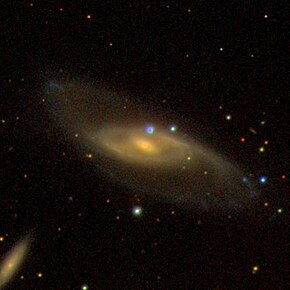
Summary
NGC 536 is a barred spiral galaxy located in the constellation Andromeda. It is located at a distance of circa 200 million light-years from Earth, which, given its apparent dimensions, means that NGC 536 is about 180,000 light years across.[1] It was discovered by William Herschel on September 13, 1784.[2] It is a member of Hickson Compact Group 10, which also includes the galaxies NGC 529, NGC 531, and NGC 542.[3] It belongs to the Perseus–Pisces Supercluster.
| NGC 536 | |
|---|---|
 NGC 536 by SDSS | |
| Observation data (J2000 epoch) | |
| Constellation | Andromeda |
| Right ascension | 01h 26m 21.8s[1] |
| Declination | +34° 42′ 11″[1] |
| Redshift | 0.017309 +/- 0.000017 [1] |
| Heliocentric radial velocity | 5,189 ± 5 km/s[1] |
| Distance | 198 ± 34 Mly (60.7 ± 10.6 Mpc)[1] |
| Apparent magnitude (V) | 12.4 |
| Characteristics | |
| Type | SB(r)b [1] |
| Apparent size (V) | 3.0′ × 1.1′[1] |
| Other designations | |
| UGC 1013, MCG +06-04-021, PGC 5344[1] | |

The nucleus of NGC 536 is characterised as a low-ionization nuclear emission-line region (LINER), a type of active galactic nucleus.[4][5] The galaxy features a bright inner region, surrounded by a ring from which emanate two faint arms with H II regions. These extended spiral arms have been suggested to be tidal tails. The galaxy has very weak Hα emission.[3] The star formation rate in NGC 536 is estimated to be 1.16[6] – 1.25[7] M☉ per year. The galaxy is seen with inclination of 78 degrees.[8]
One supernova has been observed in NGC 536, SN 1963N. It was discovered by the Palomar Supernova Search on June 27, 1963, with mag 17.7.[9]
References edit
- ^ a b c d e f g h i "NASA/IPAC Extragalactic Database". Results for NGC 536. Retrieved 2016-01-18.
- ^ Seligman, Courtney. "NGC 536 (= PGC 6983)". Celestial Atlas. Retrieved 19 November 2018.
- ^ a b Amram, P.; Plana, H.; C. Mendes de Oliveira; Balkowski, C.; Boulesteix, J. (23 April 2003). "Gas kinematics of a sample of five Hickson Compact Groups". Astronomy & Astrophysics. 402 (3): 865–877. arXiv:astro-ph/0301075. doi:10.1051/0004-6361:20030034. S2CID 55325417.
- ^ Shimada, Masashi; Ohyama, Youichi; Nishiura, Shingo; Murayama, Takashi; Taniguchi, Yoshiaki (June 2000). "The Nuclear Activity of Galaxies in the Hickson Compact Groups". The Astronomical Journal. 119 (6): 2664–2685. arXiv:astro-ph/0003056. Bibcode:2000AJ....119.2664S. doi:10.1086/301381. S2CID 17073518.
- ^ Kelm, B.; Focardi, P.; Zitelli, V. (2 April 2004). "Seyfert galaxies in UZC-Compact Groups". Astronomy & Astrophysics. 418 (1): 25–32. arXiv:astro-ph/0402029. Bibcode:2004A&A...418...25K. doi:10.1051/0004-6361:20034289. S2CID 14775667.
- ^ Verdes-Montenegro, L.; Yun, M. S.; Perea, J.; del Olmo, A.; Ho, P. T. P. (10 April 1998). "Effects of Interaction-induced Activities in Hickson Compact Groups: CO and Far-Infrared Study". The Astrophysical Journal. 497 (1): 89–107. arXiv:astro-ph/9711127. Bibcode:1998ApJ...497...89V. doi:10.1086/305454. S2CID 54584309.
- ^ Di Teodoro, E. M.; Fraternali, F. (11 July 2014). "Gas accretion from minor mergers in local spiral galaxies". Astronomy & Astrophysics. 567: A68. arXiv:1406.0856. Bibcode:2014A&A...567A..68D. doi:10.1051/0004-6361/201423596. S2CID 118462668.
- ^ Hunt, L. K.; Pierini, D.; Giovanardi, C. (27 January 2004). "Near-infrared observations of galaxies in Pisces-Perseus". Astronomy & Astrophysics. 414 (3): 905–918. arXiv:astro-ph/0311213. doi:10.1051/0004-6361:20031679.
- ^ Zwicky, F. (October 1964). "The 1963 Palomar Supernova Search". Publications of the Astronomical Society of the Pacific. 76 (452): 325. Bibcode:1964PASP...76..325Z. doi:10.1086/128107.
External links edit
- Media related to NGC 536 at Wikimedia Commons
- NGC 536 on WikiSky: DSS2, SDSS, GALEX, IRAS, Hydrogen α, X-Ray, Astrophoto, Sky Map, Articles and images
- NGC 536 on SIMBAD


